Ok! Welcome to the Tiki King "How to" section.
In this section, you will learn...
1. How to change strings
2. How to choose strings
4. Things to look for when buying a Ukulele, including some questions for Ebay, online and mail order buyers
5. Traveling with your Ukulele
6. Placing a Banjo Uke Bridge
7. Some Do's and Don'ts
Oh, and this section is kinda new and under construction, so if something is busted, don't worry, I'm working on it...
1. How to change strings.
First of all, why are you changing them? Many people will say, "Because you are supposed to..." However, this is not always the case. Regular nylon Ukulele string can last a long, long time. ( I have a set going on ten years!) In fact, other than different tunings, the only real reason to change them is if they sound bad, or show obvious wear, or you can see one is or more are about to break. So, if you are changing all the strings, be sure to put them all on before you tighten them, and when you so, do it evenly, starting with the top string, then the bottom, then the two center strings. do each on a little at a time until they are all tensioned
There are two places to be concerned with when it comes to changing strings. The pegs, and the bridge. First we will discuss the bridge.
There are three main types of bridges, and each has it's own unique way of holding the strings. First, we will talk about the most common on Ukuleles, the "slotted" bridge.
It looks like this...
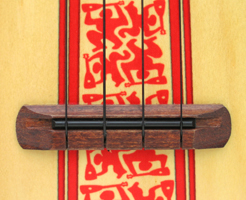
The slotted bridge holds the string by way of a knot in the end of the string that is too big to pull through the slot. It is pretty straight forward, But here is a diagram to help you tie it...
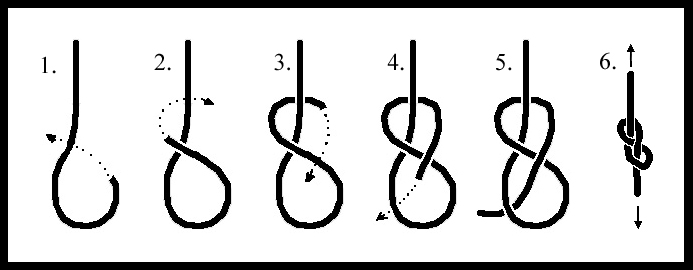
now just slip the bit just above the knot in to the slot, and pull tight. If the slot is old and warn, you may need to give the "loop" an extra twist to make the knot bigger.
Next is the "Tie" Bridge. These are most common on Tenors and Baritones. They usually look something like this...
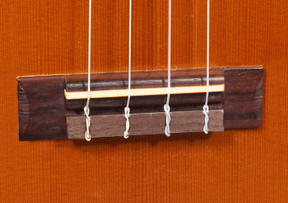
The way this type of bridge works is by feeding the string through the hole,
bringing it back up and around the string, then looping it around itself.
here is a diagram to help...
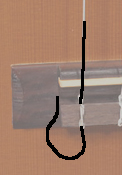
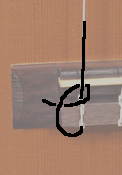
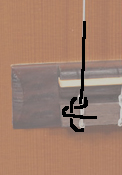
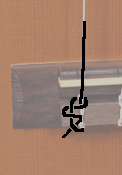
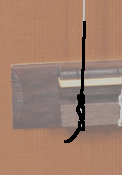
Then if you want it to look nice, you feed the ends of the strings under the other strings, like this...
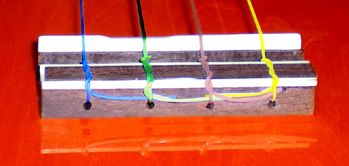
I colored the strings to make it easier to tell which is which.
Last is the Pin Bridge. These are not so common, but they are out there.
the sting is held in place by a ball or bead at the end of the string, and kept in place by a pin. Looks like this...
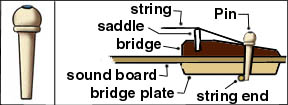
For this type of bridge you will usually need to find some beads that work, as Ukulele strings do not come with them. what you do is slip the bead onto the string, and then tie a knot so that the bead can not come off. Then you feed the end of the string with the bead through the hole in the bridge, and slip it into the small slot, then insert the pin, and push it in snug.
Now we will head to the other end, and discuss tying the string to the tuning pegs.
The most common type of Ukulele peg is the "mechanical" friction peg.
It is pretty straight forward. You push the string through the little hole in the peg, loop it around itself, and pull to tighten.
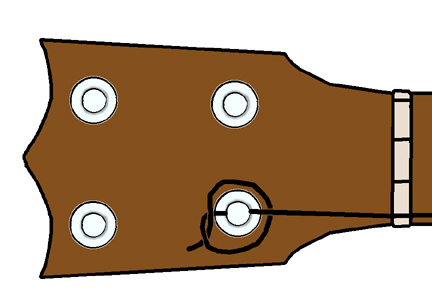
The only tricky part is that after tuning, you want to end up with the string having about three wraps around the peg. Like this...
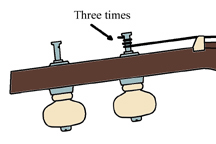
The string should wind down the peg, never up!
Next is the geared peg. There are a few types, including ones that look like friction pegs. But, the good news is they are tied the same as mechanical friction pegs.
Last is violin type friction pegs. There are two types, ones with a slot, and ones with a hole. they are both tied the same as the others, except that with a slotted peg, you push the string into the slot, rather than through a hole. They are then tied the same as the others.
Once you have all the strings in place, it is time to snug them up. again, as you tighten them, do it evenly, starting with the top string, then the bottom, then the two center strings. do each on a little at a time until they are all tensioned. Once you are happy, just snip off the extra string about a quarter of an inch from the peg.
Next, 2. How to pick strings
Back to Uke School
Ukulele, Ukelele, Ukalele, Uke!
I'm in the top 50!












